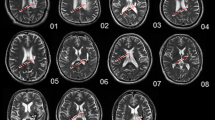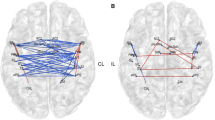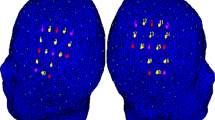Abstract
Introduction
Resting-state functional magnetic resonance imaging (fMRI) has been used to examine the brain mechanisms of stroke patients with hemiplegia, but the relationship between functional connectivity (FC) and treatment-induced motor function recovery has not yet been fully investigated. This study aimed to identify the brain FC changes in stroke patients and study the relationship between FC and motor function assessment using the resting-state fMRI.
Methods
Seventeen stroke patients with hemiplegia and fifteen healthy control subjects (HCSs) were recruited in this study. We compared the FC between the ipsilesional primary motor cortex (M1) and the whole brain of the patients with the FC of the HCSs and studied the FC changes in the patients before and after conventional rehabilitation and motor imagery therapy. Additionally, correlations between the FC change and motor function of the patients were studied.
Results
Compared to the HCSs, the FC in the patient group was significantly increased between the ipsilesional M1 and the ipsilesional inferior parietal cortex, frontal gyrus, supplementary motor area (SMA), and contralesional angular and decreased between the ipsilesional M1 and bilateral M1. After the treatment, the FC between the ipsilesional M1 and contralesional M1 increased while the FC between the ipsilesional M1 and ipsilesional SMA and paracentral lobule decreased. A statistically significant correlation was found between the FC change in the bilateral M1 and the Fugl-Meyer assessment (FMA) score change.
Conclusion
Our results revealed an abnormal motor network after stroke and suggested that the FC could serve as a biomarker of motor function recovery in stroke patients with hemiplegia.




Similar content being viewed by others
References
Gorelick PB, Scuteri A, Black SE (2011) Vascular contributions to cognitive impairment and dementia: a statement for healthcare professionals from the American Heart Association/American Stroke Association. Stroke 42(9):2672–2713
Middleton FA, Strick PL (2000) Basal ganglia and cerebellar loops: motor and cognitive circuits. Brain Res Brain Res Rev 31:236–250
Dum RP, Strick PL (2002) Motor areas in the frontal lobe of the primate. Physiol Behav 77:677–682
Ward NS, Newton JM, Swayne OB, Lee L, Thompson AJ, Greenwood RJ, Rothwell JC, Frackowiak RS (2006) Motor system activation after subcortical stroke depends on corticospinal system integrity. Brain 129(Pt 3):809–819
Stinear CM, Barber PA, Smale PR, Coxon JP, Fleming MK, Byblow WD (2007) Functional potential in chronic stroke patients depends on corticospinal tract integrity. Brain 130:170–180
Rehme AK, Eickhoff SB, Rottschy C, Fink GR, Grefkes C (2012) Activation likelihood estimation meta-analysis of motor-related neural activity after stroke. Neuroimage 59(3):2771–2782
Biswal B, Yetkin FZ, Haughton VM, Hyde JS (1995) Functional connectivity in the motor cortex of resting human brain using echo-planar MRI. Magn Reson Med 34:537–541
Carter AR, Astafiev SV, Lang CE, Connor LT, Rengachary J, Strube MJ, Pope DL, Shulman GL, Corbetta M (2010) Resting interhemispheric functional magnetic resonance imaging connectivity predicts performance after stroke. Ann Neurol 67:365–375
Wang L, Yu C, Chen H, Qin W, He Y, Fan F, Zhang Y, Wang M, Li K, Zang Y, Woodward TS, Zhu C (2010) Dynamic functional reorganization of the motor execution network after stroke. Brain 133:1224–1238
Park CH, Chang WH, Ohn SH, Kim ST, Bang OY, Pascual-Leone A, Kim YH (2011) Longitudinal changes of resting-state functional connectivity during motor recovery after stroke. Stroke 42:1357–1362
Grefkes C, Wang LENDA, Dafotakis M, Eickhoff SB, Fink GR (2010) Modulating cortical connectivity in stroke patients by rTMS assessed with fMRI and dynamic causal modelling. Neuroimage 50:233–242
Page SJ, Levine P, Leonard AC (2005) Effects of mental practice on affected limb use and function in chronic stroke. Arch Phys Med Rehabil 86:399–402
Yoo E, Park E, Chung B (2001) Mental practice effect on line-tracing accuracy in persons with hemiparetic stroke: a preliminary study. Arch Phys Med Rehabil 82(9):1213–1218
Crosbie JH, McDonough SM, Gilmore DH (2004) The adjunctive role of mental practice in the rehabilitation of the upper limb after hemiplegic stroke: a pilot study. Clin Rehabil 18:60–68
Jackson PL, Lafleur MF, Malouin F, Richards C, Doyon J (2001) Potential role of mental practice using motor imagery in neurologic rehabilitation. Arch Phys Med Rehabil 83:1133–1141
Fugl-Meyer AR, Jaasko L, Leyman I, Olsson S, Steglind S (1975) The poststroke hemiplegic patient. 1. A method for evaluation of physical performance. Scand J Rehabil Med 7:13–31
Oldfield R (1971) The assessment and analysis of handedness: the Edinburgh inventory. Neuropsychologia 9:97–113
Chao-Gan Y, Yu-Feng Z (2010) DPARSF: a MATLAB toolbox for “pipeline” data analysis of resting-state fMRI. Front Syst Neurosci 4:1–7
Wang L, Qiu M, Liu C, Yan R, Yang J, Zhang J, Zhang Y, Sang L, Zheng X (2014) Age-specific activation of cerebral areas in motor imagery—a fMRI study. Neuroradiology 56(4):339–348
Penfield W, Welch K (1951) The supplementary motor area of the cerebral cortex: a clinical and experimental study. Am Med Assoc Arch Neurol Psychiatr 66(3):289–317
Serrien DJ, Strens LH, Oliveiero A, Brown P (2002) Repetitive transcranial magnetic stimulation of the supplementary motor area (SMA) degrades bimanual movement control in humans. Neurosci Lett 328:89–92
Puh U, Vovk A, Sevsek F, Suput D (2007) Increased cognitive load during simple and complex motor tasks in acute stage after stroke. Int J Psychophysiol 63:173–180
Zimmermann-Schlatter A, Schuster C, Puhan MA, Siekierka E, Steurer J (2008) Efficacy of motor imagery in post-stroke rehabilitation: a systematic review. J Neuroeng Rehabil 14(5):8
Barclay-Goddard RE, Stevenson TJ, Poluha W, Thalman L (2011) Mental practice for treating upper extremity deficits in individuals with hemiparesis after stroke. Cochrane Database Syst Rev 11(5):CD005950
Nair VA, Young BM, La C, Reiter P, Nadkarni TN, Song J, Vergun S, Addepally NS, Mylavarapu K, Swartz JL, Jensen MB, Chacon MR, Sattin JA, Prabhakaran V (2015) Functional connectivity changes in the language network during stroke recovery. Ann Clin Transl Neurol 2(2):185–195
Yang S, Jiang C, Ye H, Tao J, Huang J, Gao Y, Lin Z, Chen L (2014) Effect of integrated cognitive therapy on hippocampal functional connectivity patterns in stroke patients with cognitive dysfunction: a resting-state FMRI study. Evid Based Complement Alternat Med 2014:962304
Acknowledgments
This work was supported by the National Natural Science Foundation of China (No.81171866), the National Key Basic Research Program of China (No.2014CB541602) and the Scientific Research Foundation for the Returned Overseas Chinese Scholars, State Education Ministry.
Author information
Authors and Affiliations
Corresponding authors
Ethics declarations
We declare that all human studies have been approved by the Third Military Medical University Ethics Committee and have therefore been performed in accordance with the ethical standards laid down in the 1964 Declaration of Helsinki and its later amendments. We declare that all patients gave informed consent prior to inclusion in this study.
Conflict of interest
We declare that we have no conflict of interest.
Rights and permissions
About this article
Cite this article
Zhang, Y., Liu, H., Wang, L. et al. Relationship between functional connectivity and motor function assessment in stroke patients with hemiplegia: a resting-state functional MRI study. Neuroradiology 58, 503–511 (2016). https://doi.org/10.1007/s00234-016-1646-5
Received:
Accepted:
Published:
Issue Date:
DOI: https://doi.org/10.1007/s00234-016-1646-5




